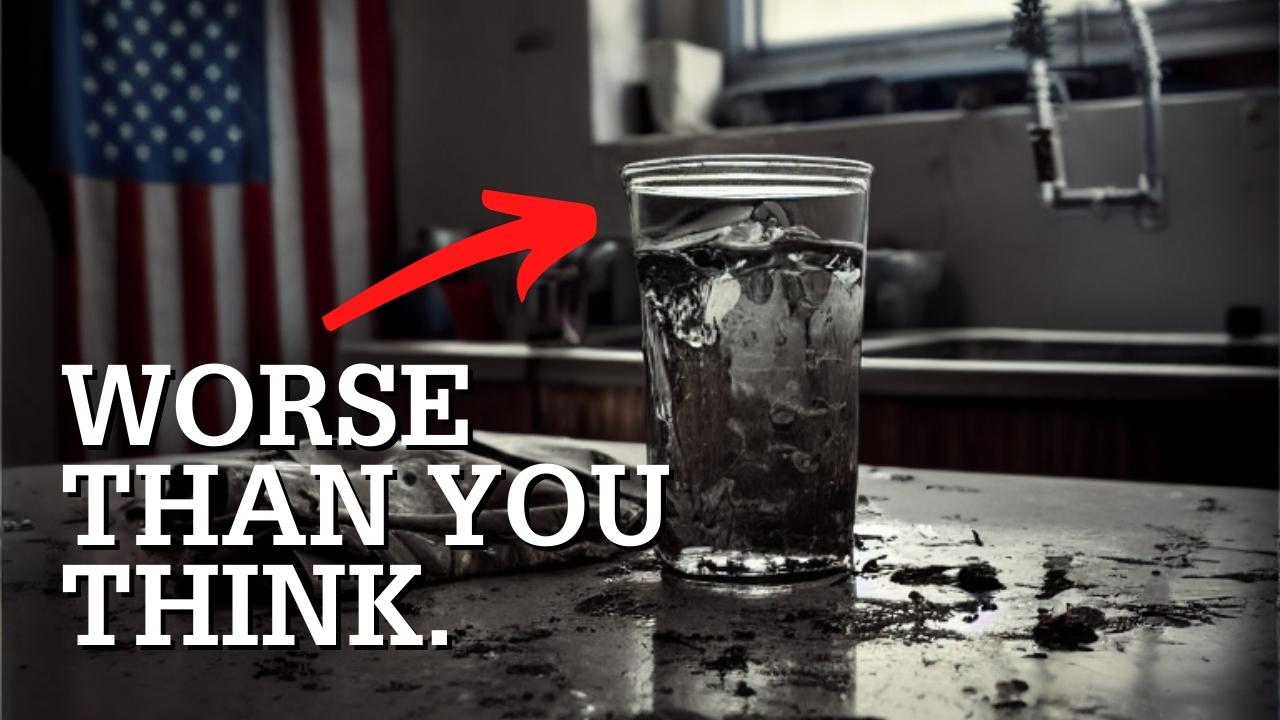“Water Apocalypse” may come in as an exaggerated stretch; I’m sorry. Yet if you want a number to understand the magnitude of what we’re discussing here: fixing America’s water challenges is estimated at… $1 trillion. So, what makes for this Water Crisis in America?
Solving the Rubiks Cube
The US Water Sector looks much like a giant Rubiks Cube right now. In fact, here would be some of the tiles:
- 63 million Americans are potentially exposed to unsafe drinking water
- 1/3 of US drinking water and wastewater operators will be eligible for retirement in the next five years
- PFOA was determined in 2022 to be 100’000 times more toxic by the US EPA than they thought in 2009
- There are 1.7 million water professionals in the US
- 85% of water and wastewater utilities have three or fewer employees
- Pipes in “Excellent” condition went from 69% in 1980 to 33% in 2020. “Very Poor” ones went from 2% to 23%.
- The country features 51’000 Water Utilities (and about 16’000 Wastewater Utilities)
- Treating PFAS would cost $370 billion.
- 2.2 million Americans have no access to water at all
- The “American Jobs Plan” proposes a $111 billion investment in water infrastructure.
- ESG assets will surpass $41 Trillion in 2022 Globally
These tiles are pretty mixed today, yet we might be at a turning point. What would it take to solve the riddle? Where can we act first? Who can help, and how?
For this investigation, I’ve left my cushy Studio to meet with twenty experts in New York. Academics, Politicians, Water Industry CEOs, Investors, Best Selling Authors, Influencers, NGO Leaders, and more, with a simple aim: getting the essence of the American Water Challenges and gathering the best solutions in order to solve this Rubiks Cube.
The series starts today with this question: What’s to Rethink in Water?
Key Learnings:
Repairing the American Water Sector will require a $1 trillion investment. This is the consequence of decades of flawed water management along four main lines.
- Broken infrastructure starts showing with nearly 15% of US citizens served with water that recently breached the Safe Water Act. When they get served at all, as 2.2 million Americans don’t get any water services.
- Water economics are in dangerous imbalance. The combined effects of the “wrong pockets problem” and recurrent underinvestment place an entire section of the Water Sector in a perilous situation.
- Policies move and adapt slower than the changing world we live in. And even when they tend to evolve, enforcement is an entirely new problem.
- Beyond policies, an entire sector struggles to embrace change – when it inevitably will have to.
Table of contents
What’s to Rethink in Water?
Would you accept “everything” as an answer? Probably not. I would even bet you would be surprised to discover how much there is to rethink in water (especially in the US). Or even that there is something to rethink at all.
Per the United Nations count, and as of 2021, that’s 2.2 billion people without clean water worldwide. And 44% of the wastewater that gets discharged untreated. But that’s not the end of it:
Water challenges are not as far away as you think
All of these challenges are vivid and daunting. Yet they suffer from a fatal disease: they get easily filtered out by our brains. Big numbers that are hard to grasp, challenges in places far away… well, really far away?
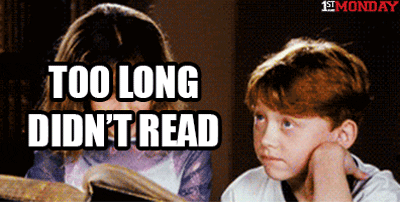
Well: it’s happening, much closer than you think, and in many more shapes than you’d expect.
Water Challenges are in our Backyard!
Upmanu Lall, again:
And indeed, as Paul Gallay highlights:
Yet, the water apocalypse has a bigger sibling that’s been relatively successful in bringing people into the equation: climate change.
Climate Change calls for a Change
Could you look me in the eyes and tell me you’ve never heard of “Zero Carbon” or climate change? I hope not – unless you have a much better poker face than Lady Gaga herself.
Yet, there’s a dichotomy a student I met in New York highlighted rightfully:
The link between siblings rapidly gets apparent, as Patrick Decker underlines:
Nick Shufro says nothing different:
So, would you now agree with me that there is something to rethink in water? I’m sure you do.
Identifying the Four Horsemen
When it comes to what we have to rethink, we start identifying patterns, as Tom Rooney underlines:
Let’s start with these broken pipes.
1 – Broken Infrastructure
The Environment Protection Agency (EPA) regularly surveys the US infrastructure, providing us with an overview of the current state of the water system but also how it evolves over time. And it’s unsettling!
- In 1980, 69% of the drinking water pipes were classified as “Excellent” and 2% as “Very Poor.”
- In 2020, only 33% made it to “Excellent,” while the “Very Poor” proportion had been multiplied by more than 10 to reach 23%!
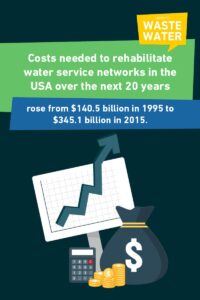
To give you a sense of the challenge, over a quarter of Philadelphia’s piping infrastructure was installed before 1900, and recent construction works in downtown Manhattan excavated… wooden drinking water pipes from the early Aaron Burr-Alexander Hamilton times.
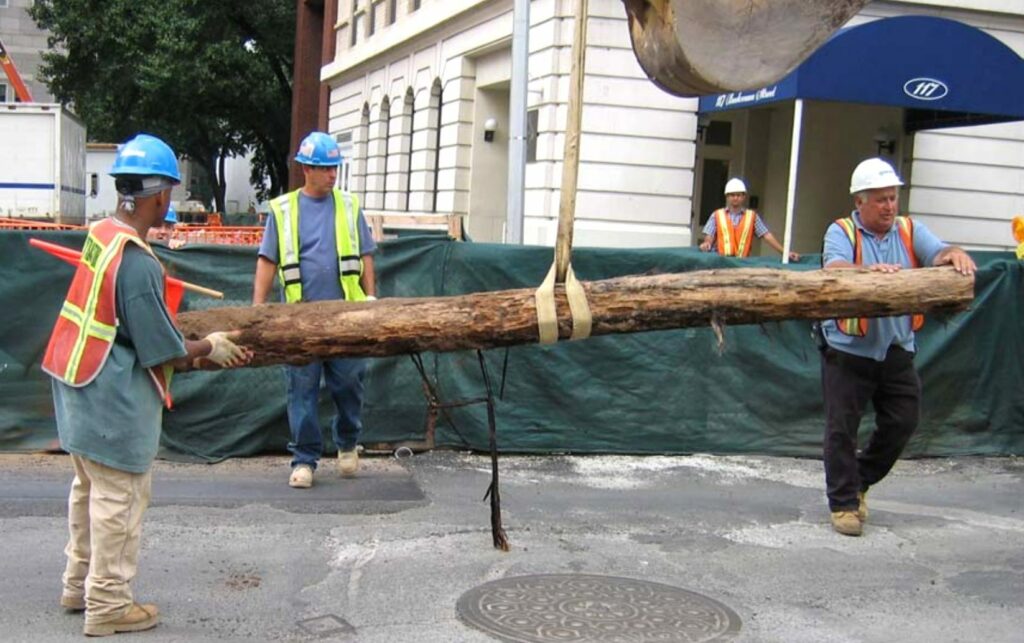
Failing Water Utilities deliver Flawed Water
When we look beyond the anecdote, we start realizing the size of the challenge:
And it goes beyond what Sean Davis explains here.
Indeed, according to Maura Allaire, Haowei Wu, and Upmanu Lall, in a 2018 study, 63 million Americans are potentially exposed to unsafe drinking water.
A 2019 study by the Natural Resource Defense Council (NRDC), Coming Clean, and the Environmental Justice Health Alliance (EJHA) even removes the “potentially” adverb by showing how almost 45 million people receive water from 5’634 water systems with a combined 23’040 health-based violations over just three years.
2.2 million Americans don’t have access to any water and wastewater services at home
That figure is picked up in Dig Deep’s “Closing the Gap” report, co-written with the US Water Alliance.
And George McGraw, Dig Deep’s CEO, is adding another astonishing statistic:
But wait, when the World’s largest economy leaves so many citizens on the roadside, arguably in the middle of a sizeable Water apocalypse in America, isn’t it a sign of broken policy? Let’s find out.
2 – Broken Policy
The 15. June 2022, the EPA published a new Drinking Water Health Advisory for PFAS Chemicals.
That publication was intentional on many levels, notably introducing advisory levels for GenX and PFBS and lowering the threshold for PFOS and PFOA.
Let’s focus on these last chemicals to sense the magnitude of that change. Compared to 2016, the EPA now determined PFOA to be 17,000 times more toxic. And compared to 2009, we talk of 100,000 times more toxicity!
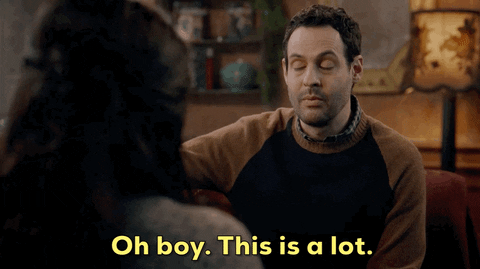
The concern about PFAS isn’t new (at all)
Yet, as Seth Siegel recalls:
Indeed, Paul Gallay confirms:
Policies are integral to the Water Apocalypse in America
If we zoom out from the PFAS topic, the picture that reveals is twofold:
- Policies have been lagging behind for a while
- Even when policies tend to catch up, they are still lousily enforced
But why would policies be so loose if water is so essential for life, economic activities, and safety on all levels?
The political trouble with undervalued water
“Simply” because water is undervalued on all levels (we’ll come back to that). So if any kind of leader starts focusing money or efforts on water, it will inevitably be questioned for all the wrong reasons, as Tom Rooney recalls.
Yet, many studies show that investing in water – be it in drinking water infrastructure when that’s not existing, in water risk prevention, or in the reconnection of people with water streams is always profitable. And sometimes even highly profitable!
So why this disconnect? Probably because of broken economics.
3 – Broken Economics
For Tom Rooney, broken economics is the root cause of the Water Apocalypse in America:
I talked about many studies just a second ago; let’s just quote some here.
- The University of Michigan demonstrated how each dollar invested in river restoration in cities like Buffalo or Detroit yielded a four-dollar windfall for the overall economy.
- The OECD demonstrated how there is a 7-to-1 benefit-to-cost ratio when it comes to rolling out water and wastewater infrastructures worldwide.
- DigDeep showed how you get a five-dollar economic return for one dollar invested in access to toilets and taps for US families.
And that’s just a succinct selection.
Wrong Pockets impact the Water Apocalypse in America
So, assuming most of the people in charge are much more clever than I am, what is it that they can’t see in such straightforward economic benefits?
Let me give you an example. A community suffers from health diseases because of tap water of doubtful quality. Nothing outrageous, but still cases of diarrhea and similar symptoms.
- It will impact businesses around because their workers will call in sick.
- Some others will lose time to boil water or travel around to get bottled water instead (at a higher expense).
- School time will be lost, impacting the community’s long-term prospects.
- Hospitals will have slightly higher occupations, and so on and so on.
Now, if the local water utility steps in and invests in solving the problem, the overall community will swiftly measure the benefits! But the utility itself won’t get any additional cent for that.
Benefits will land in the “wrong pocket.”
Is Water too cheap?
There is actually a simple symptom that underlines the entire difficulty around the economics of water:

Indeed, utilities could overcome the wrong pocket symptom if they were allowed to charge an appropriate amount for water and at least a full cost recovery.
But wait, why should they charge more for something that is freely available almost everywhere on earth? Maybe because we’ve done our semantics wrong all that time.
Water companies don’t charge for water; they charge for its collection, treatment, management, and distribution! And unlike water, that doesn’t come for free.
Why are people fine with paying 100x more for Bottled Water?
Now, that’s not the only paradox we face:
At today’s pace and by 2034, the World will spend more on bottled water than it does on utility water. Five hundred ninety-eight billion dollars a year to be spent on Evian, Aquafina, or Dasani. That’s more than the GDP of a country like Belgium.
In countries like Mexico, the inflection point where bottled water investment takes over is already crossed, while the USA is close to it. Indeed, the United States is the largest market globally for packaged water – an overwhelming majority of it for discretionary consumption.
People undervalue Water – A core reason for the Crisis in America
For all these reasons and more, it has been difficult to convey that water could be a profitable field.
Yet if we all agree that large conglomerates don’t think twice about making a profit from bottled water, we shouldn’t shy away from doing so in all infrastructure water and wastewater.
The reason why that matters the most is that it opens new avenues, as Henry Cordes underlines:
Fixing broken economics and solving the Water Apocalypse in America by leveraging new approaches? That sounds like a good prospect! Unless we get dragged into a last major threat: conservatism.
4 – Conservatism
Sure, the water sector is conservative for a full set of good reasons. You don’t want to play with your users’ health – and cities like Flint have paid to know that changes that weren’t thought through could have dramatic consequences.
Yet, there’s also that well-known saying that insanity is doing the same thing over and over again and expecting a different result.
In a changing world, the water sector isn’t evolving fast enough
The reality is that we live in a changing World, where water scarcity, aging infrastructure, intensified urbanization, and all the other drivers we’ve been listing so far change the name of the game.
So it might be time to adapt the rules as well, James Rees‘ plea:
Indeed, “new” technologies in water often aren’t that new when you look at them. Crossing the chasm in this sector rather takes decades than the months’ Silicon Valley moguls have accustomed us to.
It’s a scary world for Water Entrepreneurs
And that inertia can act as a significant inhibitor for the striving of a specific segment of water actors, which could help solve the water apocalypse in America faster: water entrepreneurs, as John Robinson recalls.
For water entrepreneurs going all-in on a technology they develop and believe in can indeed be quite scary. What if, despite proof of concepts, it suffers from death by piloting? Wouldn’t they be better off in adjacent segments like energy or agriculture?
An indicator of the Water Apocalypse in America: the aging water workforce
Worse: entrepreneurs aren’t the only resource that tends to run scarce in our conservative sector, as Errick Simmons warns:
There are about 1.7 million workers in the extended water sector in the US, but that number may soon go down.
Indeed, the 53% of water workers that have high school diplomas or less may well get paid up to 50% more than the national average for similar profiles, but the attractivity of the sector remains low.
The 85% male, 66% white demography also rounds up with water operators that are, on average, about five years older than the national median.
In 2016, when polled for a Brookings report, many utilities had shared the same alarming message: they were facing up to 50% vacancies, combined with a lack of public visibility that wasn’t drawing for a brighter future.
Conclusion
As we’ve seen, there’s a lot to rethink in water, and it might be scary.
Yet, identifying the challenges is also the first step towards solving them!
In the next chapters of this series, we’ll explore these solutions.

